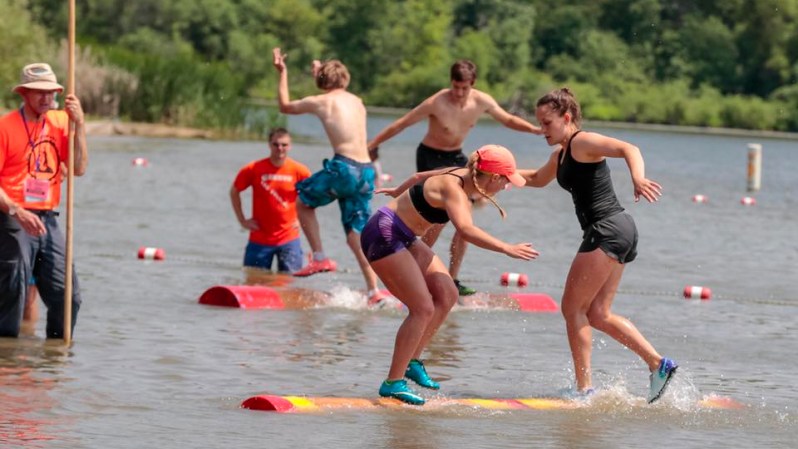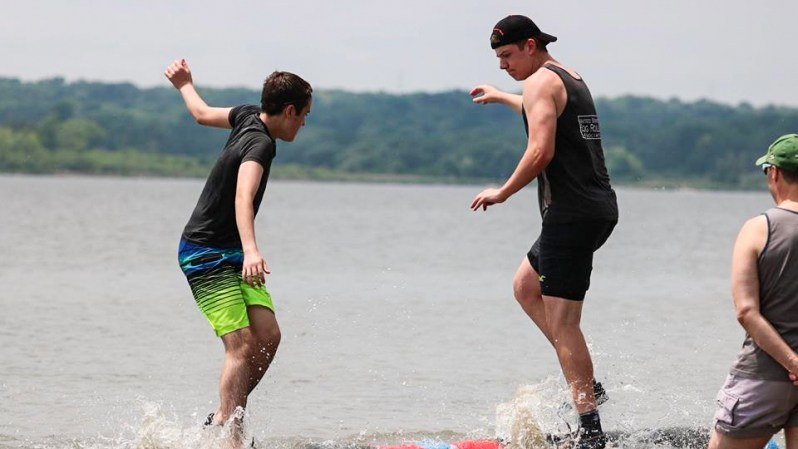Looking for a new lifestyle sport that combines dexterity, cardio, and core strength with a totally authentic machismo factor?
If so, time to pull out your granddad’s Stormy Kromer cap, find yourself a pair of spike-soled shoes, and get (re)acquainted with logrolling.

The favorite sport of the American lumberjack, logrolling began not as entertainment, but as a necessity. During the timber boom of the late 1800s, rivers were the vehicle of choice for transporting logs to the sawmill. When logjams happened, as they frequently did, intrepid lumbermen were called upon to cross from bank to bank while stepping on the floating logs in order to keep them moving along. The skill, speed, and dexterity required for this feat eventually became its own industry competition, and in the summers, competing lumber companies began sponsoring logrolling contests around the Midwest.
The skill, speed, and dexterity required for this feat eventually became its own industry competition.
The sport was so popular that it outlived the lumber industry’s decline. Troupes of log rollers would tour the United States to exhibit their skill and challenge local upstarts. As time passed, the sport became more regulated, with specifications for log size, material, and manufacture.
By the 1980s, though, the sport had more or less faded from view. Part of that was due to the limitations of the sporting equipment — finding or transporting a regulation log outside the Midwest proved a pretty big barrier to entry. However, the sport has seen a resurgence in recent years. Today, the United States Log Rolling Association (USLRA) holds over 20 sanctioned tournaments, colloquially known as “roleos.”
Part of this new popularity is undoubtedly due to a favorable shift in the zeitgeist. As one longtime “birler” (i.e., log roller) told NPR, “logrolling is rooted culturally in flannel, Red Wing boots, and burly beards.” But it can’t be denied that another major factor is the development of logrolling equipment that translates (and travels) with greater ease amongst cultures and locations.
While actual wooden logrolling logs are still made to order and supplied by Salzman Custom Sawing and Slabbing in Menomenie, Wisconsin, a Minnesota-based company called Key Log Rolling has made it super easy for anybody, anywhere, to pick up this time-honored sport.
Key Log Rolling started with a couple of crazy kids named Judy and Jay who met in Hayward, Wisconsin, where logrolling is chief among the attractions at the annual Lumberjack World Championships. The year was 1972 and the two fell in love with each other over a lathe-turned 500-pound cedar log in Lake Hayward.

A few and kids later, Judy convinced her local YMCA to let her put a log in their pool and began teaching lessons. The Y, however, balked at the use of spiked shoes, a necessity for serious contenders to achieve traction. Some time later, word came from across the ocean that Europeans were interested in a logrolling program of their own. However, nowhere in Europe could they find the right species of wood.
Practiced solo, logrolling is an exercise in zen. Competing with someone else turns it into a ferocious contest of will, skill, and primal instincts.
Each of these obstacles proved seminal in the development of the Key Log, a 65-pound synthetic log that you fill with water at your destination. With its patent-pending baffled system, the Key Log floats, spins, and reacts just like a traditional cedar wood log. Noobs are well advised to use a Key Log fitted with Trainers, a patented device that slows and stabilizes the Key Log by providing resistance to its spinning speed. Like gutters on a bowling alley or blocks in a yoga class, it’s easy to turn up your nose at this beginner’s aid until you get knocked on your ass. Seriously, start small and you’ll get good a lot faster. The company promises that what used to take months to master now can be learned in a few hours.
Practiced solo, logrolling is an exercise in zen. Competing with someone else turns it into a ferocious contest of will, skill, and primal instincts. Whether you get into it as a fitness tool or a fun summer activity, expect the learning curve to be steep. According to Key Log Rolling CEO Abby Hoeschler, a respectable first attempt lasts about 10 to 15 seconds. “You step on the log, and if you make one wrong move, you’ve lost. It requires a serious amount of focus and concentration.”

A practiced logrolling motion is a lot like climbing, which makes sense — you’re constantly trying to get to the “top” (i.e., the non-submerged side) of a rapidly rolling log. But it’s also like sprinting, and a little bit like capoeira or another martial art. Between the squatting position, the intensely engaged core, and the lightning-fast footwork, it’s no mystery why champion log rollers like J.R. Salzman and Darren Hudson sport shredded abs, ropy forearms, and quads the size of watermelons. Despite its physical demands, however, logrolling is a fairly forgiving and low-impact sport — the hardest bruise will be to your ego after hitting the water 20 or 50 times before you achieve your first few seconds of success.
Over time, you’ll learn to initiate rolling motion on your own by “cuffing” the log, surprise your opponent with a sudden “snub” (reversal of rotation), and experience the thrill of mastery by “wetting” them (knocking them into the water) while you stand dry and triumphant.
According to 10-time Log Rolling World Champion Jamie Fischer, the learning curve is steep, but worth it, as much for the community you build as the muscle tone. “It is a great form of exercise when you get the hang of it, and at the end of the day the camaraderie you build, and the people you meet are a lot of fun to hang out with,” he says.
Ready to fall into logrolling? Key Log holds invitational competitions at the brand’s Lake Minnetonka basecamp every summer. Registration deadline for 2018 is September 7 at 11 a.m. EST.
Editors' Recommendations
- 3 things you should always do on your iPhone before you go skiing or snowboarding
- Get HealthyAF at the New Fit Men Cook Amazon Store
- Rethinking the Gym: Why Men Should Try More Fitness Classes


